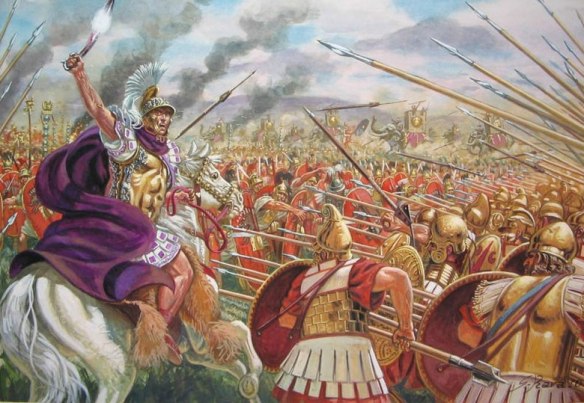Battle of Pydna
PRINCIPAL COMBATANTS: Macedon vs. Rome
PRINCIPAL THEATER(S): Southeastern Macedonia
MAJOR ISSUES AND OBJECTIVES: Rome wanted to stop Macedon’s meddling in Greek politics.
OUTCOME: Macedon was defeated; Rome divided Macedonia into republics.
APPROXIMATE MAXIMUM NUMBER OF MEN UNDER ARMS: Unknown
CASUALTIES: Macedonian losses at Pydna (168 B. C. E.) were 20,000 killed and 11,000 made prisoner; in contrast, Rome lost about 100 killed.
After Perseus (c. 212-166 B. C. E.), who had inherited the Macedonian throne from his father Philip V in 179 B. C. E., began to meddle in Greek affairs by making alliances with various Greek city-states, Rome sent an army to attack his forces at Pydna in southeastern Macedonia. Fought on June 22, 168 B. C. E., this battle proved decisive, the Macedonians lost 20,000 killed and 11,000 taken as prisoners; Roman losses amounted to no more than 100 killed.
L. Aemilius Paullus (cos. 182, 168), the son of the general killed at Cannae, was elected consul for the year 168. He arrived in Greece and immediately reestablished discipline in his army. He then moved east to confront Perseus. Perseus had taken up a position on the Elpeus River, which guarded the eastern, coastal road into Macedonia. Unable to force Perseus’s position, Paullus sent a military tribune, P. Cornelius Scipio Nasica Corculum (cos. 162, 155), with 8,000 soldiers, to take another route into Macedonia while Paullus held Perseus at the Elpeus. Nasica and his men moved almost in a complete circle: south to Heraclea, then southwest through the Vale of Tempe, and then north and west along the western side of Mount Olympus across a narrow pass, eventually moving east and dropping down behind and to the north of Perseus. Perseus, believing his position had been turned, quickly retreated from the Elpeus, allowing Paullus and the main Roman army to march through.
The two armies encamped near each other, separated only by the small Leucus River. On June 22, 168, both sides moved out of their camps and were drawn up for battle, yet, after remaining on the field, for some time both sides withdrew. But then a strange event took placed that sparked a major battle. Late in the day, a Roman pack animal broke away from its handlers and sprinted across the narrow river. A few Romans gave chase and ran into Thracian soldiers serving in Perseus’s army. A brief skirmish ensued, which gradually grew larger until significant numbers of troops were drawn in from both sides. Apparently, Perseus decided that now was as good a time as any and went all in, forming up his army for battle. Paullus did likewise. The Battle of Pydna had begun.
The Roman army was lined up in the traditional fashion: legions I and II in the center flanked by two allied infantry alae, with the cavalry on the wings. There was one nontraditional element: 22 elephants stationed on the right in between the infantry and the cavalry. The Macedonian army consisted of units that would have been familiar to Philip II and that were very different from those of the Seleucid or Ptolemaic monarchies. Various contingents of Macedonian hoplites drawn up in the traditional phalanx manned the center. These units included the Bronze and the White Shields and the agema, the elite royal guard. On the wings was the Macedonian cavalry.
The Macedonian phalanx advanced. Paullus later spoke of the sight: “The great strength of the wall of shields . . . bristling with arms, I was seized with amazement and fear having never seen anything like it.” Paullus, though, hid his fears from his men, calmly riding through his army without breastplate or helmet while smiling. Initially, Paullus’s internal fears seemed justified; the Macedonian phalanx pushed inexorably forward, and the Roman infantry was forced to give ground. But, as the Macedonians moved forward, the ground rose uphill and became broken, slowing their progress and creating gaps in the line. The flexibility of the Roman legions again proved its worth as the small maniple units, armed with short swords, then moved back downhill and quickly penetrated the gaps in the enemy line. At the same time, the Roman right, spearheaded by the elephants and the cavalry, broke the Macedonian left and then attacked the Macedonian phalanx from the flanks and from the rear. Under this incredible pressure, the phalanx broke. More than 20,000 Macedonians fell on the field of Pydna, and another 11,000 were captured. The last battle ever fought by the Macedonian army ended in defeat; the superiority of the Roman legion was again demonstrated.
The following year, Perseus was dethroned and made captive. To ensure that Macedon would never again threaten the stability of the Roman world, the victors divided it into four republics. However, this only succeeded in causing internal conflict, as the republics soon fell to disputing with one another. In a climate of discontent and confusion, a pretender to the throne attempted to reestablish the Macedonian monarchy in 152 B. C. E., an action that ignited the Fourth MACEDONIAN WAR.
Further reading: M. Cary, A History of the Greek World from 323 to 146 B. C. (New York: Barnes and Noble, 1963); N. G. L. Hammond, The Macedonian State (New York: Oxford University Press, 1989); Victor Davis Hanson, The Wars of the Ancient Greeks (New York: Sterling, 2002); J. F. Lazenby, Hannibal’s War: A Military History of the Second Punic War (Warminster, England: Aris and Phillips, 1978); Colin Wells, The Roman Empire, 2nd ed. (Cambridge, Mass.: Harvard University Press, 1995).
